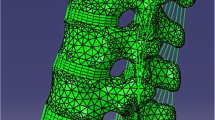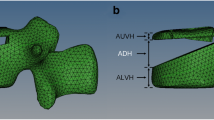Background
Use of a pedicle screw at the level of fracture, also known as an intermediate screw, has been shown to improve clinical results in managing lumbar fracture, but there is a paucity of biomechanical studies to support the claim. The aim of this study was to evaluate the effect of adding intermediate pedicle screws at the level of a fracture on the stiffness of a short-segment pedicle fixation using monoaxial or polyaxial screws and to compare the strength of monoaxial and polyaxial screws in the calf spine fracture model.
Materials and Methods
Flexibility of 12 fresh-frozen calf lumbar spine specimens was evaluated in all planes. An unstable burst fracture model was created at the level of L3 by the pre-injury and dropped-mass technique. The specimens were randomly divided into monoaxial pedicle screw (MPS) and polyaxial pedicle screw (PPS) groups. Flexibility was retested without and with intermediate screws (MPSi and PPSi) placed at the level of fracture in addition to standard screws placed at L2 and L4.
Results
The addition of intermediate screws significantly increased the stability of the constructs, as measured by a decreased range of motion (ROM) in flexion, extension, and lateral bending in both MPS and PPS groups (P < 0.05). There was neither any significant difference in the ROM in the spines of the two groups before injury, nor a difference in the ROM between the MPSi and PPSi groups (P > 0.05), but there was a significant difference between MPS and PPS in flexion and extension in the shortsegment fixation group (P < 0.05).
Conclusions
The addition of intermediate screws at the level of a burst fracture significantly increased the stability of shortsegment pedicle screw fixation in both the MPS and PPS groups. However, in short-segment fixation group, monoaxial pedicle screw exhibited more stability in flexion and extension than the polyaxial pedicle screw.
Similar content being viewed by others
References
Verlaan JJ, Diekerhof CH, Buskens E, van der Tweel I, Verbout AJ, Dhert WJ, et al. Surgical treatment of traumatic fractures of the thoracic and lumbar spine: A systematic review of the literature on techniques, complications, and outcome. Spine 2004;29:803–14.
Roy-Camille R, Saillant G, Mazel C. Internal fixation of the lumbar spine with pedicle screw plating. Clin Orthop Relat Res 1986;203:7–17.
Roy-Camille R, Saillant G, Mazel C. Plating of thoracic, thoracolumbar, and lumbar injuries with pedicle screw plates. Orthop Clin North Am 1986;17:147–59.
Dick W. The “fixateur interne” as a versatile implant for spine surgery. Spine 1987;12:882–900.
Alanay A, Acaroglu E, Yazici M, Oznur A, Surat A. Short-segment pedicle instrumentation of thoracolumbar burst fracture: does transpedicular intracorporeal grafting prevent early failure? Spine (Phila Pa 1976) 2001;26:213–7.
Kramer DL, Rodgers WB, Mansfield FL. Transpedicular instrumentation and short-segment fusion of thoracolumbar fractures: A prospective study using single instrumentation system. J Orthop Trauma 1995;9:499–506.
McCormack T, Karaikovic E, Gaines RW. The load sharing classification of spine fractures. Spine (Phila Pa 1976) 1994;19:1741–4.
McLain RF, Sparling E, Benson DR. Early failure of shortsegment pedicle instrumentation for thoracolumbar fractures. A preliminary report. J Bone Joint Surg Am 1993;75:162–7.
Shen WJ, Liu TJ, Shen YS. Nonoperative treatment versus posterior fixation for thoracolumbar junction burst fractures without neurologic deficit. Spine (Phila Pa 1976) 2001;26:1038–45.
Mahar A, Kim C, Wedemeyer M, Mitsunaga L, Odell T, Johnson B, et al. Short-segment fixation of lumbar burst fractures using pedicle fixation at the level of the fracture. Spine (Phila Pa 1976) 2007;32:1503–7.
Lü FX, Huang Y, Zhang Q, Shi FL, Zhao DS, Hu Q. Pedicle screw fixation against burst fracture of thoracolumbar vertebrae. Chin J Traumatol 2007;10:349–52.
Anekstein Y, Brosh T, Mirovsky Y. Intermediate screws in short segment pedicular fixation for thoracic and lumbar fractures: A biomechanical study. J Spinal Disord Tech 2007;20:72–7.
McKinley TO, McLain RF, Yerby SA, Sharkey NA, Sarigul-Klijn N, Smith TS. Characteristics of pedicle screw loading. Effect of surgical technique on intravertebral and intrapedicular bending moments. Spine (Phila Pa 1976) 1999;24:18–24. discussion 25.
Fogel GR, Reitman CA, Liu W, Esses SI. Physical characteristics of polyaxial-headed pedicle screws and biomechanical comparison of load with their failure. Spine (Phila Pa 1976) 2003;28:470–3.
Stanford RE, Loefler AH, Stanford PM, Walsh WR. Multiaxial pedicle screw designs: static and dynamic mechanical testing. Spine (Phila Pa 1976) 2004;29:367–75.
Shepard MF, Davies MR, Abayan A, Kabo JM, Wang JC. Effects of polyaxial pedicle screws on lumbar construct rigidity. J Spinal Disord Tech 2002;15:233–6.
Tsai KJ, Murakami H, Horton WC, Fei Q, Hutton WC. Pedicle screw fixation strength:a biomechanical comparison between 4.5-mm and 5.5-mm diameter screws in osteoporotic upper thoracic vertebrae. J Surg Orthop Adv 2009;18:23–7.
Wang XY, Dai LY, Xu HZ, Chi YL. Biomechanical effect the extent of vertebral body fracture on the thoracolum bar spine with pedicle screw fixation: an in vitro study. J Clin Neurosci 2008;15:286–90.
Jacob AT, Ingalhalikar AV, Morgan JH, Channon S, Lim TH, Torner JC, et al. Biomechanical comparison of single- and dual-lead pedicle screws in cadaveric spine. J Neurosurg Spine 2008;8:52–7.
Freslon M, Mosnier T, Gayet LE, Skalli W. Biomechanical evaluation of posterior instrumentation for lumbar burst fracture: comparison of two internal devices. Rev Chir Orthop Reparatrice Appar Mot 2007;93:213–21.
Guven O, Kocaoglu B, Bezer M, Aydin N, Nalbantoglu U. The use of screw at the fracture level in the treatment of thoracolumbar burst fractures. J Spinal Disord Tech 2009;22:417–21.
Uzumcugil O, Dogan A, Yetis M, Yalcinkaya M, Caniklioglu M. Results of ‘two above- one below approach’ with intermediate screws at the fracture site in the surgical treatment of thoracolumbar burst fractures. Kobe J Med Sci 2010;56:E67–78.
Chen SH, Mo Lin R, Chen HH, Tsai KJ. Biomechanical effects of polyaxial pedicle screw fixation on the lumbosacral segments with an anterior interbody cage support. BMC Musculoskelet Disord 2007;8:28.
Liu T, Zheng WJ, Li CQ, Liu GD, Zhou Y. Design and biomechanical study of a modified pedicle screw. Chin J Traumatol 2010;13:222–8
Aerssens J, Boonen S, Lowet G, Dequeker J. Interspecies differences in bone composition, density, and quality: potential implications for in vivo bone research. Endocrinology 1998;139:663–70.
Allan DG, Russell GG, Moreau MJ, Raso VJ, Budney D. Vertebral end-plate failure in porcine and bovine models of spinal fracture instrumentation. J Orthop Res 1990;8:154–6.
Chapman JR, Harrington RM, Lee KM, Anderson PA, Tencer AF, Kowalski D. Factors affecting the pullout strength of cancellous bone screws. J Biomech Eng 1996;118:391–8.
Coe JD, Warden KE, Herzig MA, McAfee PC. Influence of bone mineral density on the fixation of thoracolumbar implants. A comparative study of transpedicular screws, laminar hooks, and spinous process wires. Spine (Phila Pa 1976) 1990;15:902–7.
Wittenberg RH, Shea M, Swartz DE, Lee KS, White AA 3rd, Hayes WC. Importance of bone mineral density in instrumented spine fusions. Spine (Phila Pa 1976) 1991;16:647–52.
Acosta FL Jr, Buckley JM, Xu Z, Lotz JC, Ames CP. Biomechanical comparison of three fixation techniques for unstable thoracolumbar burst fractures. Laboratory investigation. J Neurosurg Spine 2008;8:341–6.
Kuklo TR, Dmitriev AE, Cardoso MJ, Lehman RA Jr, Erickson M, Gill NW. Biomechanical contribution of transverse connectors to segmental stability following long segment instrumentation with thoracic pedicle screws. Spine (Phila Pa 1976) 2008;33:E482–7.
Author information
Authors and Affiliations
Corresponding author
Rights and permissions
About this article
Cite this article
Wang, H., Li, C., Liu, T. et al. Biomechanical efficacy of monoaxial or polyaxial pedicle screw and additional screw insertion at the level of fracture, in lumbar burst fracture: An experimental study. IJOO 46, 395–401 (2012). https://doi.org/10.4103/0019-5413.98827
Published:
Issue Date:
DOI: https://doi.org/10.4103/0019-5413.98827




